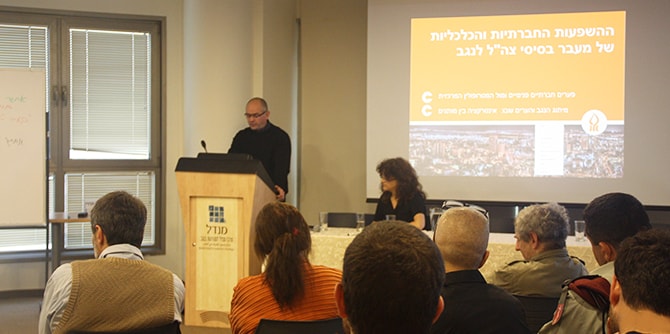In late January, a conference was held at the Mandel Center for Leadership in the Negev to mark the completion of a study titled “The Social and Economic Effects of the Relocation of IDF Bases to the Negev.” The research was funded by the Ministry of Science and Technology, and was conducted by two research groups, each which explored different aspects of the issue.
The first session focused on the social and urban consequences of the IDF's relocation of army bases from central Israel to the Negev, and was led by
Professor Nurit Alfasi of the geography and environmental development department at Ben-Gurion University of the Negev. The second session, led by
Dr. Itzhak (Kiki) Aharonovich of the Mandel Center for Leadership in the Negev, explored the impact of the influx of career soldiers to the Negev.
The findings presented at the conference revealed a complex picture. Alongside the growth that the relocation of the bases has sparked in certain areas and aspects of life in the Negev, the gaps between the center of the country and the southern periphery continue to grow. Towns in the Negev are still perceived as weak, in line with traditional perceptions of the periphery. It may be noted that the city of Beer Sheva is seen as the greatest beneficiary of the move. This is due to the investments that have been made there and to the improving image of the city among its residents, residents of the Negev, and the residents of central Israel who are slotted to move there. In addition, there is recognition that relocation of IDF bases alone is not sufficient to be a “game changer” for the Negev; developing this region requires leveraging the relocation by additional bodies, including government authorities, civil society organizations, and businesses, and especially by the residents of the Negev themselves.
The conference was attended by approximately 60 participants, and facilitated an important and fruitful encounter among public sector officials, academics, social activists, the general public, and fellows of the Mandel Program for Local Leadership in Yeruham and Ramat Hanegev. The encounter itself, the presentation of the findings, and the discussions that ensued contributed to a meaningful experience for all those in attendance. The conference also served as an excellent introduction to the study unit on “Reality, Society, and Place” of the Mandel Program for Local Leadership in Yeruham and Ramat Hanegev.

